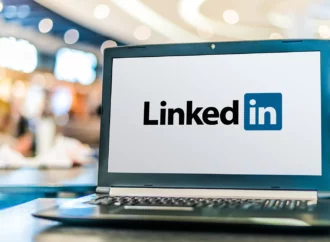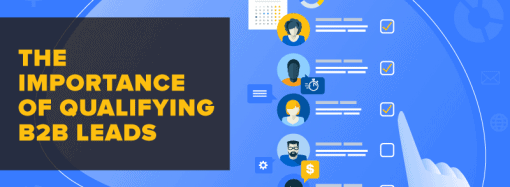How You Can Use B2B Storytelling to Stand Out You’re just about to throw in the towel. As any B2B business should, you’re doing everything by the book: you’ve published tons of marketing content, you implemented blogging, you’re using email automation, you’re scraping for comments on your Facebook company page, and at this point, read
How You Can Use B2B Storytelling to Stand Out
You’re just about to throw in the towel. As any B2B business should, you’re doing everything by the book: you’ve published tons of marketing content, you implemented blogging, you’re using email automation, you’re scraping for comments on your Facebook company page, and at this point, read hundreds of articles for “best practices” for lead generation. You’re frustrated. After all, how can a B2B business stand out from the competition on social media and elsewhere? What more can be done?
You’ve probably heard the term ‘storytelling’ in the marketing sphere. Before you turn your cheek and say ‘I’m B2B, that doesn’t apply to me’, we have a secret to share with you: B2B storytelling is the greatest tool in your B2B marketing arsenal.
What You’ll Find in This Article:
- What is storytelling in marketing?
- How you can tell your B2B story.
- Calculating ROI of storytelling strategy.
- Brands that leverage storytelling.
What is Storytelling in Marketing?
Since the dawn of human civilization, we naturally gravitate towards storytelling. Emotional narratives resonate with us and drives us to reminiscence, change our views, or take action. It’s a no-brainer that this applies to the sales process, no matter where potential leads are in the buyer journey. In fact, advertising research shows that emotion is the greatest factor in buyer intent.
This explains why people tend to be loyal or prefer to buy from certain brands than others—they want to be included in their story. People will choose what they’re emotionally connected to over functionality any day.
Stories are not advertisements. A story does not promote any product or service directly. Rather, it gives the company an opportunity to voice a statement, to show that there are people behind the brand, or make an ethical stance.
How YOU Can Tell Your B2B Story
Let’s talk about the essential elements of a storytelling campaign:
- Setting
- Characters
- Conflict
- Plot
- Resolution
- Action
Setting
The setting is straight-forward: where is the story taken place? The city or country-side or maybe something local like an office? When is it? Modern or sometime in the past? Relevancy is an important factor to consider depending on who the audience is.
Characters
Who are your characters? Consider their gender, age, race, educational background, social class, and job. Are they young, fresh out of college adults? The middle-class working man? The businesswoman and mother of two? Depending on who you want to target, you’ll want to make your characters relatable.
Conflict
What’s the conflict your characters are facing? Are they struggling with change, in need of something, facing a life situation, or need their voice to be heard? Think about the tone you want to go for: light-hearted, humorous, or emotionally heavy?
Plot:
Now, here’s the bulk of it: plot. What initiated your characters to want a change? How are your characters going to resolve their conflict? Is it a long journey or just a couple of steps? Does it take physical action or a change in mindset? Most importantly, is it doable to your viewers?
Resolution
What’s the defining resolution? What does success look like to your characters? Have they changed for the better? What’s their life like now that they overcame their conflict? Think about the purpose of this story. Is the main takeaway courage? Love? Resilience? Teamwork?
Action
Lastly, how will your viewers take action to be included in the narrative? Using a hashtag to add to the conversation on social media? Share with friends or colleagues who might relate to the story? Donate to a charity? Take into account the delivery: A video? Series of interviews? A podcast? Blog posts? A combination of presentations?
These questions are to help you construct your story, but don’t limit yourself—the most successful storytelling campaigns are the ones that are specific and unique to your business.
Calculating ROI for Storytelling Strategy
Now, you might be wondering: How can I measure ROI? How can something creative and abstract translate to marketing analytics?
First, take a look at your pain points: Are potential leads clicking on your Google ad but clicking off your website? Are your current clients not opening your email marketing campaigns? Do you have tons of views on your Facebook post but zero engagement? Use these pain points to identify your goals and tools like data visualization software needed to create the story framework. This will also give you an idea on where to emphasize your story.
Next, take into account human resources, talent, and tools needed to complete the storytelling project. This will help with measuring ROI in the long-run which will be in the form of cost outlays and selected metrics. You’ll want to track cost and profit over the full course of the storytelling campaign.
Most importantly, don’t neglect marketing technology. Investing in analytical research such as search algorithms and SEO will help point to the right direction when creating and timing content. Consider the multimodality of a story campaign—text, graphics, animation, video, voice, etc.—and the different platforms from it will channel the message.
At this point, the standard procedure of setting KPIs comes into place: social media statistics website traffic, lead generation, and response and conversion rates along with cost-per-click (CPC) and customer acquisition cost (CAC). But remember: storytelling is about the bigger picture. Remember those pain points we established? Use data visualization to show how your storytelling campaign impacted these weak areas by emotionally engaging with the potential lead or customer.
Ultimately, storytelling breathes life into a business. It brings value that no product or service, no matter its superb quality, can achieve. It makes your business a person; that alone makes you stand out from the competition.
Brands That Leverage Great Storytelling
Cisco
The technology conglomerate Cisco, known for its networking and telecommunications hardware, launched a documentary series “The Network Effect”. It tells the story of how service providers helped pave the way for the development of mobile communications and social media. The campaign involved a series of videos on YouTube and their website.
Why it was successful
The documentary was nominated in the 2012 American Business Awards for Best Motivational Video and Film category. The video campaign received over 137,000 views on YouTube and even screened at Mobile Word Congress and featured on ShortsHDTV.
Cisco aimed to increase “…awareness of the socioeconomic impact the network has in bringing education and access to services, allowing microbusinesses in the third world to compete globally.” As a result, Cisco is perceived as a thought-leader and passionate about the networking field, recognizing its history and inserting themselves in the story as it continues today.
GE (General Electric)
Created by their in-house marketing team, The Grid, the iconic company GE launched a sci-fi podcast series called The Message. The series garnered a massive audience, with over 8 million downloads and reaching to the Top 20.
Why it was successful
Not only was the experimental project a success in numbers, but the podcast also managed to creatively feature GE technology at the core of the story. Its listeners no longer see General Electric as a cold corporation but instead a company that likes to innovate with storytelling on the latest platforms.
The professional and business-focused social platform LinkedIn launched a series of stories about their users called Celebrate Success. Each short video focuses on a member of the company and their journey of how they achieved their goals.
Why it was successful
There’s been a number of times when LinkedIn aims to divert from the typical ‘white-collar professional’ stereotype on their platform, such as with the In it Together campaign. This storytelling campaign is no different, as it casts a light on their users in a real, authentic way. These strides help attract diverse users to their platform, particularly millennials as they enter the workforce.
Ready to tell your story? We’ve got you covered.
We’re here to provide the strategies you need. Contact us and learn what options are right for you.
















